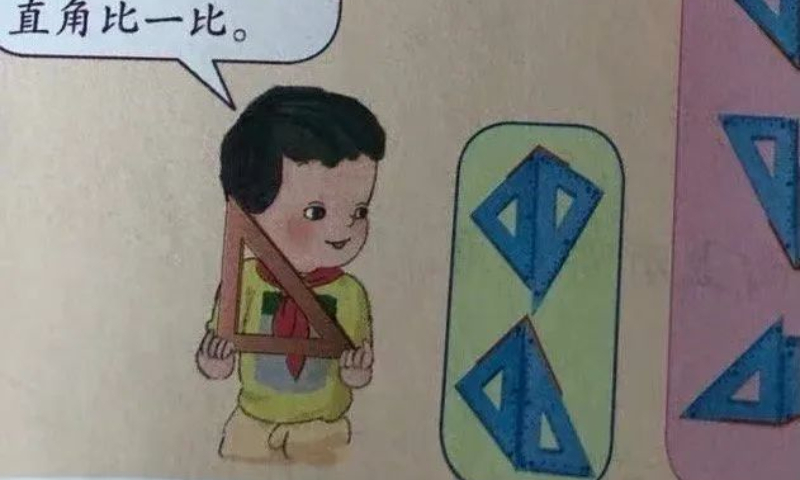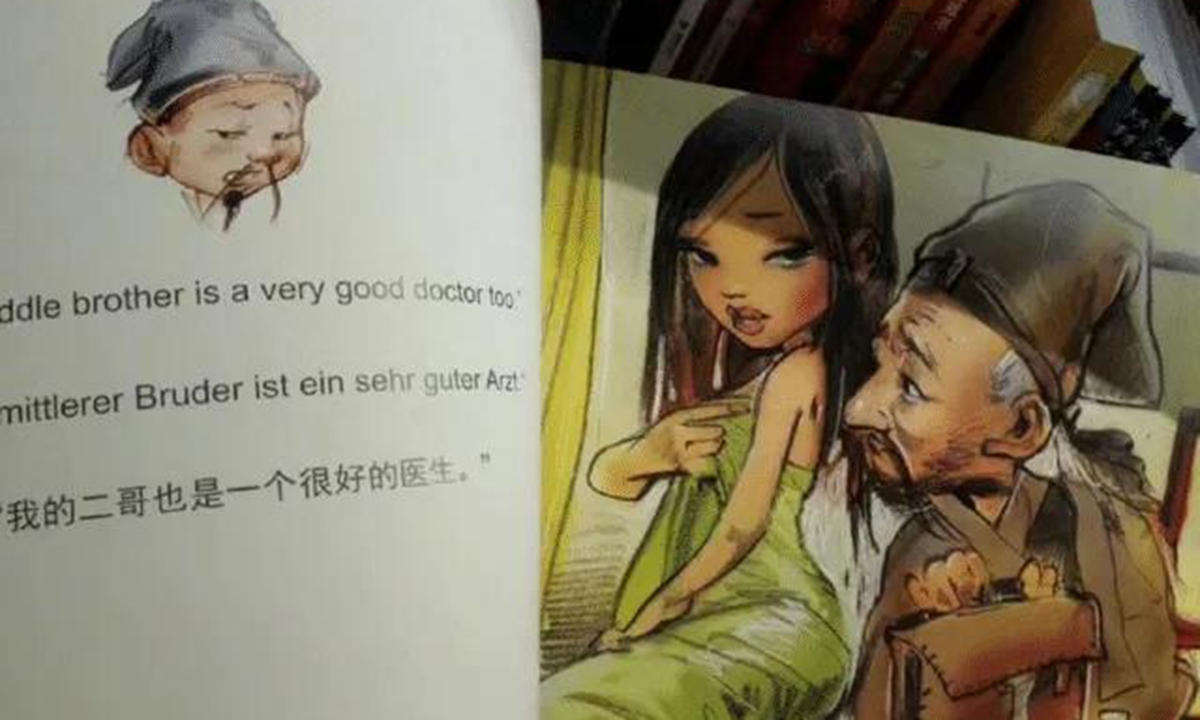
Screenshot of the controversial textbook Photo: Screenshot from Sina Weibo
The "ugly textbook illustration" scandal is brewing, with a growing number of Chinese netizens and state-owned media outlets calling for a thorough investigation into problematic press houses and penalties against relevant personnel, after illustrations in a national publisher's textbooks sparked uproar for being racist and pornographic.
Legal Daily, a Chinese state-owned newspaper under the supervision of the Commission for Political and Legal Affairs of the Communist Party of China Central Committee, published an article on Sunday, calling for strict and comprehensive accountability for the responsible personnel over the textbook scandal, noting that the People's Education Press' apology and promise to rectify the issue won't be enough to solve the problem.
The topic "Rectifying poisonous textbooks cannot skip responsibility seeking" was trending on China's Twitter-like Sina Weibo, with more than 320 million views and comments as of press time.
The controversial covers and illustrations of the textbooks will be redrawn and a full evaluation of all published textbooks will be launched, the
People's Education Press said as it apologized on Thursday.
The publisher on Saturday said they had reflected on public concern and felt a deep sense of guilt. A work team has been established to rectify the issues raised.
They will selecting quality designers to replace all the illustrations in the elementary school math textbooks, and make sure new math textbooks can be used in the new semester in the fall.
On Saturday, China's Ministry of Education (MOE)
ordered a thorough inspection of elementary and middle school textbooks nationwide and urged the People's Education Press to rectify.
The controversy started when snapshots of the math textbooks went viral, showing some children depicted in strange poses, including crooked mouths, tongues sticking out and squinting eyes. Some were depicted wearing clothes mimicking the US national flag.
The incident continued to ferment anger as the public uncovered more serious problems than just ugly figures. Photos of the textbooks showed boys seemingly wearing no pants and an explicitly depicted male reproductive organ. An illustration of children playing together depicted a boy putting his hands on a girl's breast and another pulling on a girl's skirt. A leaping girl's underwear was completely exposed in one picture.
"It is not about aesthetics ... (the illustrations) are disguised malice," one Weibo user commented. "I remember adding mustache to illustration figures when I was young. Actually children pay even more attention to pictures than texts. What impression will children get for this 'garbage'? wrote another.
China's publishing regulations stipulate that publications aimed at minors shall not contain content that induces minors to imitate acts that violate social morality or commit crimes, or content that is harmful to their physical and mental health, such as horror or cruelty. Those who publish or import publications containing such content and violating the criminal law shall be investigated for criminal responsibility.
Education is the foundation of the Chinese national rejuvenation, the Legal Daily stressed, warning that poisonous textbooks and picture books would come out again if the government did not get to the root of the problem and hold the relevant people accountable.
Floods of netizens spontaneously joined in a campaign to report more problematic teaching materials for minors.

Screenshot of the controversial illuatration Photo:Sina Weibo
For example, illustrations called Bianque Healing Diseases from a trilingual version of a children's picture book showed men and women were rarely dressed, with ambiguous facial expressions and postures.
According to information on the shopping platform, suitable for kids aged from three to six, the picture book says it combines the creativity and wisdom of Chinese and German artists, and integrates Eastern and Western cultures and traditions to help children learn to think and understand life.
However, many netizens accused the illustrations of full of sexual connotation. The publisher, Sichuan Children's Publishing House, responded to media by saying it has revised the illustrations before publication. However, some controversial pictures remained in the book. The publisher explained that the picture was retained for coherent context, and the woman's back was exposed to show a wound, which was not modified after communication with the author.
A publishing house - Hangzhou Qihai Book Group - said on Sunday that given the recent controversy over textbook illustrations, all published children's picture books and comics were required to be fully examined. The publisher said it would thus delay the publication of new comics and sales of comic strip cards.
The trending topic over the textbook scandal reflected the increasing attention paid to talent cultivation, Zhu Wei, vice director of the Communication Law Research Center at the China University of Political Science and Law, told the Global Times on Sunday.
Textbook publishing must undergo strict management with high-level standards to make sure that they are suited to mainstream values and aesthetics, Zhu said.





